
Ham is pork from a leg cut that has been preserved by wet or dry curing, with or without smoking. As a processed meat, the term "ham" includes both whole cuts of meat and ones that have been mechanically formed.
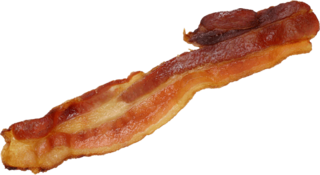
Bacon is a type of salt-cured pork made from various cuts, typically the belly or less fatty parts of the back. It is eaten as a side dish, used as a central ingredient, or as a flavouring or accent.

A sausage is a type of meat product usually made from ground meat—often pork, beef, or poultry—along with salt, spices and other flavourings. Other ingredients, such as grains or breadcrumbs may be included as fillers or extenders.

Braunschweiger is a type of sausage. The type of sausage the term refers to varies by region. In the German language, Braunschweiger is the demonym for people from Brunswick, but under German food law refers to a variety of mettwurst. In Austria, Braunschweiger is known as a type of parboiled sausage (Brühwurst), while American Braunschweiger is often confused with liverwurst.

Chorizo is a type of pork sausage originating from the Iberian Peninsula. It is made in many national and regional varieties in several countries on different continents. Some of these varieties are quite different from each other, occasionally leading to confusion or disagreements over the names and identities of the products in question.
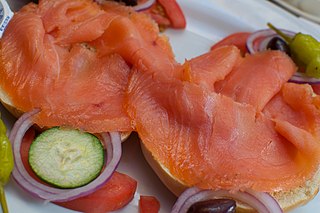
Lox is a fillet of brined salmon, which may be smoked. Lox is frequently served on a bagel with cream cheese, and often garnished with tomato, onion, cucumber, and capers.
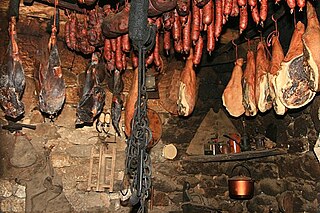
Smoked meat is the result of a method of preparing red meat, white meat, and seafood which originated in the Paleolithic Era. Smoking adds flavor, improves the appearance of meat through the Maillard reaction, and when combined with curing it preserves the meat. When meat is cured then cold-smoked, the smoke adds phenols and other chemicals that have an antimicrobial effect on the meat. Hot smoking has less impact on preservation and is primarily used for taste and to slow-cook the meat. Interest in barbecue and smoking is on the rise worldwide.

Pancetta is a salt-cured pork belly meat, product in a category known as salume. In Italy, it is often used to add depth to soups and pastas.

A lardon, also spelled lardoon, is a small strip or cube of fatty bacon, or pork fat, used in a wide variety of cuisines to flavor savory food and salads. In French cuisine, lardons are also used for larding, by threading them with a needle into meats that are to be braised or roasted. Lardons are not normally smoked, and they are made from pork that has been cured with salt.

Pork ribs are a cut of pork popular in Western and Asian cuisines. The ribcage of a domestic pig, meat and bones together, is cut into usable pieces, prepared by smoking, grilling, or baking – usually with a sauce, often barbecue – and then served.

Charcuterie is a French term for a branch of cooking devoted to prepared meat products, such as bacon, ham, sausage, terrines, galantines, ballotines, pâtés, and confit, primarily from pork.
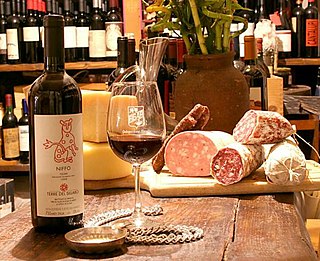
Salumi are Italian meat products typical of an antipasto, predominantly made from pork and cured. Salumi also include bresaola, which is made from beef, and some cooked products, such as mortadella and prosciutto cotto.
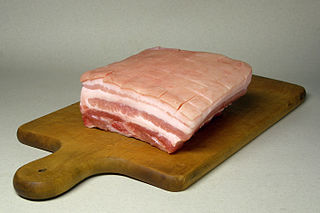
Pork is the culinary name for the meat of the pig. It is the most commonly consumed meat worldwide, with evidence of pig husbandry dating back to 5000 BCE.

The cuts of pork are the different parts of the pig which are consumed as food by humans. The terminology and extent of each cut varies from country to country. There are between four and six primal cuts, which are the large parts in which the pig is first cut: the shoulder, loin, belly and leg. These are often sold wholesale, as are other parts of the pig with less meat, such as the head, feet and tail. Retail cuts are the specific cuts which are used to obtain different kinds of meat, such as tenderloin and ham. There are at least 25 Iberian pork cuts, including jamón.

Salt pork is salt-cured pork. It is usually prepared from pork belly, or, more rarely, fatback. Salt pork typically resembles uncut side bacon, but is fattier, being made from the lowest part of the belly, and saltier, as the cure is stronger and performed for longer, and never smoked. The fat on the meat is necessary for the curing process as it allows the salt to soak in and preserve the meat. Salt pork is made by layering salt and thin layers of meat, then dousing it in a brine mixture once the desired size has been reached.

Bacon and Hams is a 1917 book by George J. Nicholls, a member of the Institute of Certificated Grocers. The book details the then-modern bacon and ham industry beginning with the use of the pig breeds, meat processing and the distribution and pricing of cuts with a focus on the United Kingdom. The meat processing aspects focus on the popular Wiltshire cut of the time, but also includes American cuts as well. The book was described, with approbation, by the Saskatchewan Overseas Livestock Marketing Commission, as an "admirable and important treatise". Despite having entered the public domain, the book is rare and collectible and generated interest for its "unparalleled" anatomical details of pigs found in its fold-out pages.
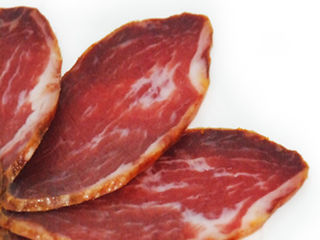
Cured pork tenderloin is found in various cuisines in Mediterranean Europe and South America. It is typically salted or brined then dry-cured or smoked.

Peameal bacon is a wet-cured, unsmoked back bacon made from trimmed lean boneless pork loin rolled in cornmeal. It is found mainly in Ontario. Toronto pork packer William Davies, who moved to Canada from England in 1854, is credited with its development.

Speck can refer to a number of European cured pork products, typically salted and air-cured and often lightly smoked but not cooked. In Germany, speck is pickled pork fat with or without some meat in it. Throughout much of the rest of Europe and parts of the English-speaking culinary world, speck often refers to South Tyrolean speck, a type of Italian smoked ham. The term "speck" became part of popular parlance only in the eighteenth century and replaced the older term "bachen", a cognate of "bacon".






















